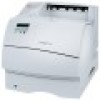Lexmark T620 Technical Reference - Page 162
File and Device Protection Commands, Protecting a File or Device, Password Protection for a File
 |
View all Lexmark T620 manuals
Add to My Manuals
Save this manual to your list of manuals |
Page 162 highlights
3-92 PJL File and Device Protection Commands The following information applies to password protection. • You can set both read/write and write passwords for a resource. If both passwords are set, the read/write password has precedence over the write password. • If you attempt to password protect a non-existing resource, the PJL interpreter will return a warning (CODE = 25001). • If a resource has already been password protected, the resource must be "unlocked" before you can specify a different password for that resource. • Several restrictions with passwords apply to flash due to the nature of the technology: - You can create/change passwords for the whole flash multiple times, but each change uses up free space in the flash that can only be recovered by reformatting the whole flash. - You can create passwords for individual resources on the flash only once. You can also delete this password once. If this is done, you must recreate the resource before using the password feature again. Protecting a File or Device Use the DEFAULT command to set a password on the entire flash or disk or on an individual macro or font in flash. Password Protection for a File LRWLOCK with DEFAULT specified locks a file or device for reading and writing. LWLOCK with DEFAULT specified locks a file or device for writing only. Syntax: @PJL DEFAULT LRESOURCE:"device:filename.filetype" LRWLOCK="password"[] @PJL DEFAULT LRESOURCE:"device:filename.filetype" LWLOCK="password"[] The filename used depends on whether you wish to put a password on a font or a macro.















